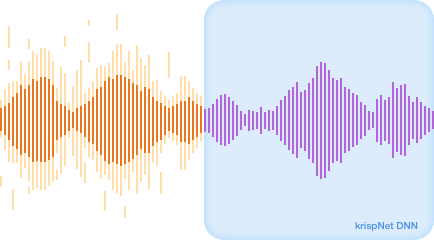If your luck is anything like mine, as soon as you jump on an important call, someone decides it’s a great time to blow some leaves off the sidewalk outside your window. 2Hz’s Krisp is a new desktop app that uses machine learning to subtract background noise like that, or crowds, or even crying kids — while keeping your voice intact. It’s already out for Macs and it’s coming to Windows soon.
I met the creators of Krisp, including 2Hz co-founder Davit Baghdasaryan, earlier this year at UC Berkeley’s Skydeck accelerator, where they demonstrated their then-prototype tech.
The tech involved is complex, but the idea is simple: If you create a machine learning system that understands what the human voice sounds like, on average, then it can listen to an audio signal and select only that part of it, cutting out a great deal of background noise.
Baghdasaryan, formerly of Twilio, originally wanted to create something that would run on mobile networks, so T-Mobile or whoever could tout built-in noise cancellation. This platform approach proved too slow, however, so they decided to go straight to consumers.
“Traction with customers was slow, and this was a problem for a young startup,” Baghdasaryan said in an email later. However, people were loving the idea of ‘muting noise,’ so we decided to switch all our focus and build a user-facing product.”
That was around the time I talked with them in person, incidentally, and just six months later they had released on Mac.
It’s simple: You run the app, and it modifies both the outgoing and incoming audio signals, with the normal noisy signal going in one end and a clean, voice-focused one coming out the other. Everything happens on-device and with very short latency (around 15 milliseconds), so there’s no cloud involved and nothing is ever sent to any server or even stored locally. The team is working on having the software adapt and learn on the fly, but it’s not implemented yet.
Another benefit of this approach is it doesn’t need any special tweaking to work with, say, Skype instead of Webex. Because it works at the level of the OS’s sound processing, whatever app you use just hears the Krisp-modified signal as if it were clean out of your mic.
They launched on Mac because they felt the early-adopter type was more likely to be on Apple’s platform, and the bet seems to have paid off. But a Windows version is coming soon — the exact date isn’t set, but expect it either late this month or early January. (We’ll let you know when it’s live.)
It should be more or less identical to the Mac version, but there will be a special gaming-focused one. Gamers, Baghdasaryan pointed out, are much more likely to have GPUs to run Krisp on, and also have a real need for clear communication (as a PUBG player I can speak to the annoyance of an open mic and clacky keys). So there will likely be a few power-user features specific to gamers, but it’s not set in stone yet.
You may wonder, as I did, why they weren’t going after chip manufacturers, perhaps to include Krisp as a tech built into a phone or computer’s audio processor.
In person, they suggested that this ultimately was also too slow and restrictive. Meanwhile, they saw that there was no real competition in the software space, which is massively easier to enter.
“All current noise cancellation solutions require multiple microphones and a special form factor where the mouth must be close to one of the mics. We have no such requirement,” Baghdasaryan explained. “We can do it with single-mic or operate on an audio stream coming from the network. This makes it possible to run the software in any environment you want (edge or network) and any direction (inbound or outbound).”
If you’re curious about the technical side of things — how it was done with one mic, or at low latency, and so on — there’s a nice explanation Baghdasaryan wrote for the Nvidia blog a little while back.
Furthermore, a proliferation of AI-focused chips that Krisp can run on easily means easy entry to the mobile and embedded space. “We have already successfully ported our DNN to NVIDIA GPUs, Intel CPU/GNA, and ARM. Qualcomm is in the pipeline,” noted Baghdasaryan.
To pursue this work the company has raised a total of $2 million so far: $500K from Skydeck as well as friends and family for a pre-seed round, then a $1.5 M round led by Sierra Ventures and Shanda Group.
Expect the Windows release later this winter, and if you’re already a user, expect a few new features to come your way in the same time scale. You can download Krisp for free here.

